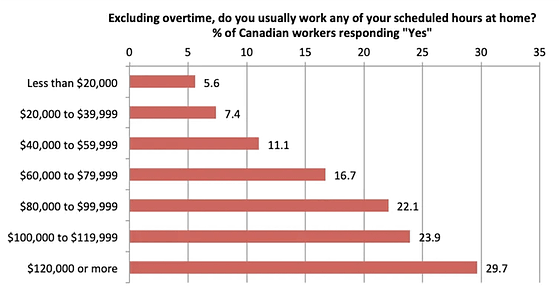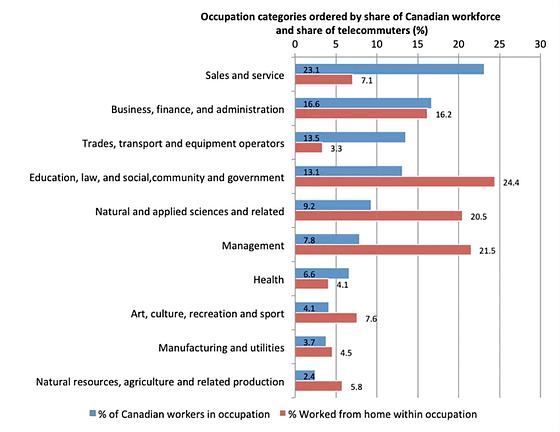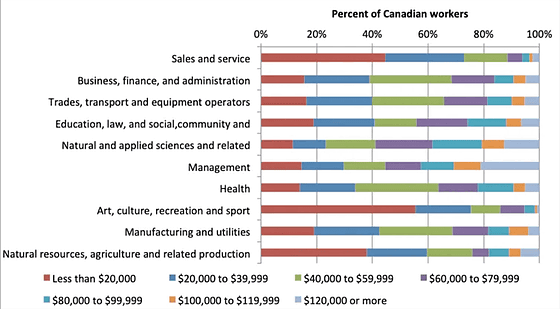Working from home promotes 'inequality of wealth'

As a measure against new-type coronavirus infectious disease (COVID-19), 'work from home' has been recommended in many countries around the world. However, the problem of 'working at home accelerates wealth inequality' was pointed out by professors Georges A. Tanguy and Associate Professor Hugo Lachapel of the University of
Remote work worsens inequality by mostly helping high-income earners
https://theconversation.com/remote-work-worsens-inequality-by-mostly-helping-high-income-earners-136160
As part of COVID-19 measures, countries such as the United States encourage “working from home” to reduce contact between people unless they go out. However, not all jobs are possible working from home, and according to data from the United States Department of Labor Labor Statistics, only 34% of jobs can work from home.
Survey results that only 34% of `` work from home '' is possible-GIGAZINE

Professor Tanguy and his colleagues point out that there are many occupations that allow working from home in high-income occupations. According to a 2015 survey conducted by Canada's General Social Survey, 5.6% of those who answered that they 'work from home' are in the income range of less than $ 20,000 a year (about 2.1 million yen). On the other hand, it was 29.7% in the income range with annual income of 120,000 dollars (13 million yen) or more.

The percentage of teleworkers by occupation type is as follows. The blue graph shows the ratio of the occupation to all occupations, and the red graph shows the telecommuting rate for the occupation. Job types with many low-income earners, such as `` Sales and service '' and `` Trades, transport and equipment operators '', have a low work-at-home rate and `` Education, law, and Work rates with a high number of high-income earners such as social, community and government, natural and applied sciences and related, and management increase the work-at-home ratio. is.

The annual income distribution of workers belonging to each occupation is as follows.

From the above survey results, Professor Tanguy and colleagues argue that 'the COVID-19 pandemic puts an excessive burden on low-income earners .' Low-income people are not able to work from home with low risk of COVID-19 infection, and restaurant employees are also at risk of being dismissed in this pandemic. On the other hand, high-income earners are expected to further widen the 'difference between rich and poor' because working hours from home are shortened by working at home, ensuring a good work-life balance and reducing the risk of dismissal.
Professor Tanguy and his colleagues also mention the general benefits of working from home. According to a 2011 (PDF file) survey conducted in Canada, homeworkers tend to spend less on food, clothes, and mobility, and if they work from home two days a week, they spend $ 600 (about 60,000 a year). It's estimated that you can save as much as $ 3,500 (about 380,000 yen) to 4000 yen.

Demand for working from home is growing in the COVID-19 pandemic, and 34% of workers said, 'If you can work from home, you are willing to accept a 5% salary reduction,' according to a study by Owl Labs , which sells video conferencing devices. 24% said that they would 'accept 10% down'.
The Canadian government has implemented compensation policies for low-income people such as ' Canada emergency response benefit ', and some supermarket labor unions negotiated 'to increase the hourly wage by $ 2 (about 210 yen)' etc. We are appealing for improved treatment for non-home workers. In this way, Professor Tanguy and others argue that 'more should be done to correct inequality.' As part of that, we will increase the number of people working from home to work at home, provide the PCs and other equipment needed to work from home, and provide subsidies and financial incentives to companies that work from home. I am proposing.
Related Posts:
in Note, Posted by darkhorse_log






